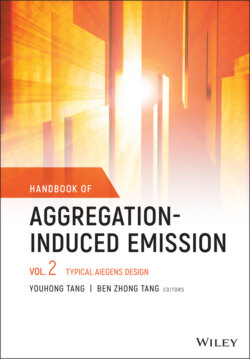Читать книгу Handbook of Aggregation-Induced Emission, Volume 2 - Группа авторов - Страница 42
3.1.2 Universal Design of SSB‐based AIEgens
ОглавлениеThe current generic SSB AIEgens are designed in two ways. As mentioned above, the key factor for SSB derivatives to generate aggregation‐induced fluorescence is the intramolecular hydrogen bonding that helps the entire molecule to rotate around the nitrogen–nitrogen or carbon–nitrogen single bond and ensure the AIE and ESIPT processes. Therefore, the protection and deprotection of hydroxyl groups enable the design and synthesis of most SSB‐based AIE probes and stimuli‐responsive materials. Substitution of protons on the hydroxyl group into specific recognition groups by chemical modifications, the probe can achieve fluorescence “off–on” switch after interaction with an analyte.
Another characteristic property of SSB is the coordination ability with metal ions. The nitrogen atom on the imine structure and the oxygen atom on the hydroxyl group are affluent in lone‐pair electrons, and the spatial conformation is close in size to that of metal ions such as copper(II) and zinc(II). Coordination with metal ions results in quenching or enhancement of fluorescence, depending on the nature of metal ions. This is also one common design approach for the SSB fluorescent probes. For metal ions or other analytes that can interact with metal ions, highly sensitive detection based on changes in the fluorescence intensity of SSB or SSB–metal complexes can be performed.
Since it was first reported in 2009 [7], the AIE properties of SSB molecules have been widely applied in designing fluorescent probes and fluorescent functional materials in chemistry, biology, and environmental science. This chapter summarizes the design and application of SSB as AIEgens of fluorescent probes and materials, for detection and imaging of metal ions, for biologically and environmentally related molecules, and as stimuli‐responsive materials and nanoparticles (NPs).
